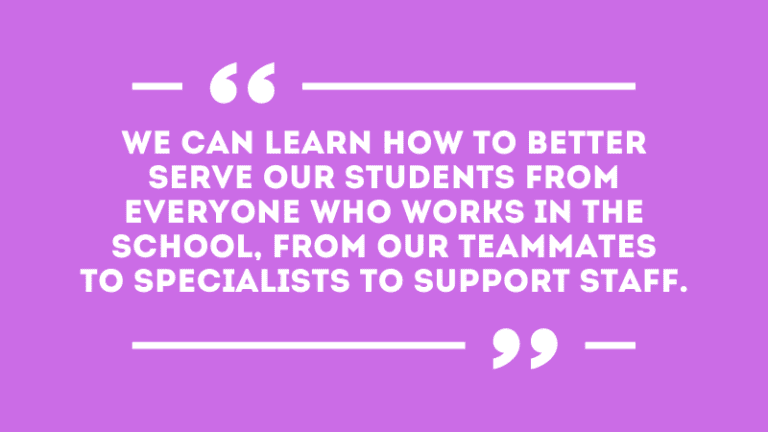Teachers have always relied on their teammates, but wow! Teaching in the pandemic has really brought to light how important having a great team is and how much we really need each other. It’s true—teachers sometimes feel like they exist on their own little island. But in times like these, we need to share the load and have each other’s backs.
And from what we hear, teachers are, as usual, rising to the occasion. We talked with teachers at two different schools and reached out to members of our WeAreTeachers HELPLINE group on Facebook. Here are some of the ways they told us grade-level teams are collaborating more than ever to share the load.
By dividing the work by subject matter
Many grade-level teams have decided that their best strategy is to divide and conquer. Helpline member Rachel S. reports, “Splitting curriculum design by subject seems to be working for us.” So one teacher plans all the reading instruction, another plans the math instruction, and so on. Then, they share those plans with their teammates, who then have a ready-to-go lesson without the stress of planning.
At Boulder Community School of Integrated Studies (BCSIS), teachers Suzanne and Erin are not only splitting up the planning; they are splitting up the instruction as well. Their first graders enjoy having both teachers throughout the day. And having fewer subjects to worry about has lessened the stress levels for both teachers.
By timesharing the day
Another interesting way teachers are sharing the workload is by switching off in-person and remote teaching. Teachers who don’t have health exemptions are eager to get back in the classroom with kids (it’s the best part of the job, after all!). So some teams are having one teacher teach in-person in the morning, then teach online in the afternoon and vice versa for the other teacher. That way, both teachers get a dose of that precious face to face time with kids as well as the calmer experience of connecting virtually.
[contextly_auto_sidebar]
By dividing the class into online learners/in-person learners
In other cases, when one member of the team (or more) needs to teach online due to a health concern, the other teacher (or teachers) teaches entirely in-person. At BCSIS, Kiley teaches the in-person kids, and Barbara teaches online. The numbers don’t exactly match up, but the teacher with fewer students takes on other duties to make up for it. The team still plans together and touches base daily to make sure that all of their first graders are getting an equitable experience.
By helping each other with tech issues
Learning and using all the necessary tech has been the steepest part of the learning curve for many teachers. Helpline member Roberta N. reports her team is “collaborating by sharing the load of creating digital versions of our in-person work for use by the remote students. As each of us makes something, it automatically goes to the others.”
Elementary Principal Jeannie Tynecki has a similar example. One of her grade level teams planned an outdoor learning event for their students. This was no easy task, with all of the additional safety protocols and procedures required by the district. The event was a smashing success, and when they were done, the team generously shared the entire lesson plan with all of the teachers.
By using each others’ strengths
Helpline member Jordan N. reports that her team is working with each individual’s strengths in mind. “My team is splitting up creating lessons,” she says. ‘We work together to make an overall plan/outline and then decide who is doing what based on strengths/likes/who has what materials. It is the only way I’m making it through this year with my sanity intact!”
By making sure the workload is balanced
The teachers we’ve talked with are working very hard to keep their team’s workload as balanced as possible. When one teacher feels swamped, the others step in. After all, they say a team is only as strong as its weakest (or most vulnerable) member. Teacher Juliette L.’s son was getting married, and she had a substitute scheduled weeks in advance. When the sub fell through, her two teammates each took half of her students so she could enjoy the special occasion without stressing.
By checking in on each other
This is probably the most important way grade-level teams are collaborating. Check in for a quick connection on a human level and try doing small things to help make this crazy time seem more bearable. Taking a quick walk, making extra copies, ensuring the secret chocolate jar is always full, giving each other air high fives—little things that make everyone feel seen and understood.
Tynecki credits her teachers for the tremendous effort they have put in to creating a strong, healthy culture. “It really pays off,” she says. “In our building, we’re focusing on three words to get us through this year: flexibility, patience, and grace. And always, in everything we do, we’re trying to remember, ‘It’s not about ME, it’s about US.”
How are your grade-level teams collaborating to share the load during COVID? Come share (and hear from other teachers) in our WeAreTeachers Helpline group on Facebook.
Also, check out Check In On Your Teacher Friends, Because We Are Not Okay.


